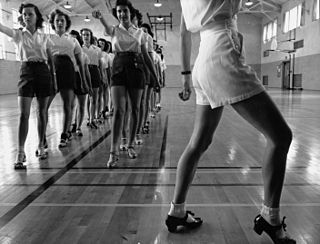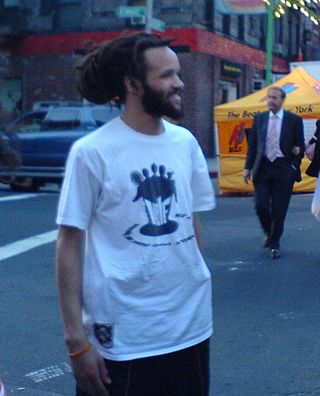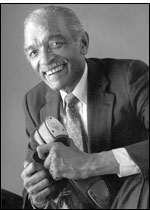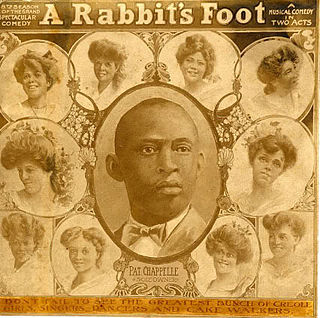
Tap dance is a form of dance which uses the sounds of tap shoes striking the floor as a form of percussion; it is often accompanied by music. Tap dancing can also be a cappella, with no musical accompaniment; the sound of the taps is its own music.

Savion Glover is an American tap dancer, actor, and choreographer.

Bill Robinson, nicknamed Bojangles, was an American tap dancer, actor, and singer, the best known and the most highly paid Black entertainer in the United States during the first half of the 20th century. His long career mirrored changes in American entertainment tastes and technology. His career began in the age of minstrel shows and moved to vaudeville, Broadway theatre, the recording industry, Hollywood films, radio, and television.

Harold Lloyd Nicholas was an American dancer specializing in tap. Nicholas was the younger half of the tap-dancing pair the Nicholas Brothers, known as two of the world's greatest dancers. His older brother was Fayard Nicholas. Nicholas was featured in such musicals as An All-Colored Vaudeville Show (1935), Stormy Weather (1943), The Pirate (1948), and The Five Heartbeats (1991).
Dianne Walker, also known as Lady Di, is an American tap dancer. Her thirty-year career spans Broadway, television, film, and international dance concerts. Walker is the artistic director of TapDancin, Inc. in Boston, Massachusetts.

James Titus Godbolt, known professionally as Jimmy Slyde and also as the "King of Slides", was an American tap dancer known for his innovative tap style mixed with jazz.

Charles “Honi” Coles was an American actor and tap dancer, who was inducted posthumously into the American Tap Dance Hall of Fame in 2003. He had a distinctive personal style that required technical precision, high-speed tapping, and a close-to-the-floor style where "the legs and feet did the work". Coles was also half of the professional tap dancing duo Coles and Atkins, whose specialty was performing with elegant style through various tap steps such as "swing dance", "over the top", "bebop", "buck and wing", and "slow drag".

Howard "Sandman" Sims was an African-American tap dancer who began his career in vaudeville. He was skilled in a style of dancing that he performed in a wooden sandbox of his own construction, and acquired his nickname from the sand he sprinkled to alter and amplify the sound of his dance steps. "They called the board my Stradivarius," Sims said of his sandbox.
Charles Green was an American tap dancer. Green was born in Fitzgerald, Georgia. He would stick bottle caps on his bare feet as a child and tap dance on the sidewalk for money. He won third place in a dance contest in 1925, in which Noble Sissle was the bandleader. Soon, Green would be touring the South tap dancing.
Ernest "Brownie" Brown was an African American tap dancer and last surviving member of the Original Copasetics. He was the dance partner of Charles "Cookie" Cook, with whom he performed from the days of vaudeville into the 1960s, and of Reginald McLaughlin, also known as "Reggio the Hoofer," from 1996 until Brown's death in 2009.
Charles “Cookie” Cook was a tap dancer who performed in the heyday of tap through the 1980s, and was a founding member of the Copasetics. He was the dance partner of Ernest “Brownie” Brown, with whom he performed from the days of vaudeville into the 1960s. They performed in film, such as Dorothy Dandridge 1942 “soundie” Cow Cow Boogie, on Broadway in the 1948 musical Kiss Me, Kate, twice at the Newport Jazz Festival, as well in other acts, including “Garbage and His Two Cans” in which they played the garbage cans. He headlined venues including New York's Palace, the Apollo, Radio City Music Hall, Cotton Club, and London Palladium. Quoted as saying “if you can walk, you can dance,” Cook was one of the most influential tap masters and crucial in passing on the tap tradition to future generations.
The Original Copasetics were an ensemble of star tap dancers formed in 1949 on the death of Bill Bojangles Robinson that helped to revive the art of tap. The first group included composer/arranger Billy Strayhorn and the choreographer Cholly Atkins, as well as Honi Coles, Charles “Cookie” Cook and his dance partner Ernest “Brownie” Brown. Other dancers included Chuck Green, Jimmy Slyde, Buster Brown and Howard “Sandman” Sims. The group took its name from Robinson’s familiar observation that “everything is copasetic” and was honored in the 1989 Broadway revue Black and Blue.
The Flo-Bert Award honors "outstanding figures in the field of tap dance".
Bunny Briggs was an American tap dancer who was inducted into the American Tap Dancing Hall of Fame in 2006.

Black Vaudeville is a term that specifically describes Vaudeville-era African American entertainers and the milieus of dance, music, and theatrical performances they created. Spanning the years between the 1880s and early 1930s, these acts not only brought elements and influences unique to American black culture directly to African Americans but ultimately spread them beyond to both white American society and Europe.

Mable Lee, sometimes spelled Mabel Lee, was an American jazz tap dancer, singer, and entertainer. Lee appeared on Broadway, at the Apollo Theater, and was known as "Queen of the Soundies" due to her numerous performances in the films.
Michelle Dorrance is an American tap dancer, performer, choreographer, teacher and director. Awarded a MacArthur "Genius Grant", she is the Founder and artistic director of Dorrance Dance. Dorrance is known for her creative ensemble choreography, rhythm tap style and ambitious collaborative projects with fellow tap dance choreographers and musicians. She is currently a 2017 Choreographic Fellow at New York City Center and an Artist in Residence at the American Tap Dance Foundation. Dorrance lives in Brooklyn, New York.
Tap City, the New York City Tap Festival, was launched in 2001 in New York City. Held annually for approximately one week each summer, the festival features tap dancing classes, choreography residencies, panels, screenings, and performances as well as awards ceremonies, concert performances, and Tap it Out, a free, public, outdoor event performed in Times Square by a chorus of dancers. The goal of the Festival is to establish a "higher level of understanding and examination of tap’s storied history and development.”
Eddie Rector was an American tap dance artist and master of ceremonies. His career spanned the 1920s-40s as he danced in Harlem, across the US, and in Europe. He is known as a “soft shoe expert,” and he invented the Slap Step. Rector was the protégé of John Leubrie Hill and later danced as a team with Ralph Cooper. He danced in notable revues including Darktown Follies (1914), Tan Town Topics (1926), Blackbirds of 1928, Hot Rhythm (1930), Rhapsody in Black (1931), Blackberries of 1932, and Yeah Man (1932).
Gary "Pete" Nugent was an American tap dancer known as "Public Tapper, Number 1". He was also part of the class act, Pete, Peaches, and Duke.











